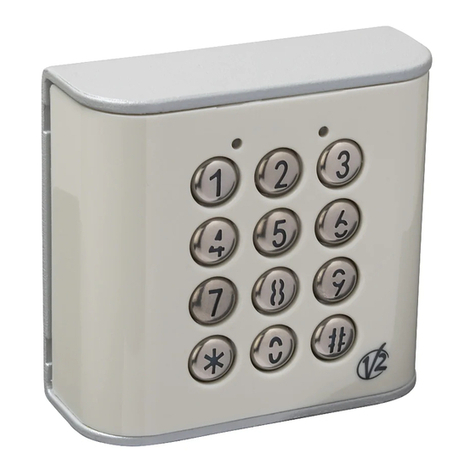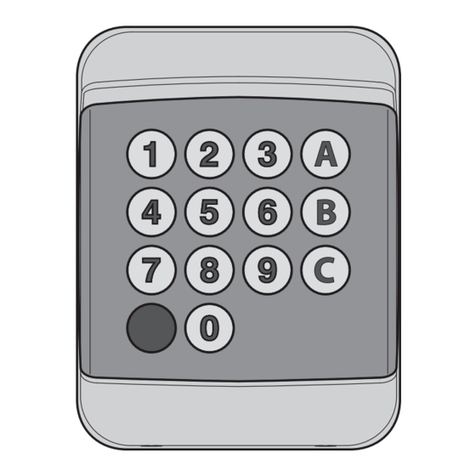
ENGLISH
- 10 -
SIRMO-DIGIT DIGITAL SWITCH
• The digital switch is a transmitter that is activated by entering
a personalised 1 to 8 character combination on the special,
back-lit numerical keypad
• On entering the correct access code, the switch transmits a
digital code by radio or cable, depending on the exact version.
• They can be programmed with up to 9 different channels
• Available in radio (powered by two 1.5 Volt AAA batteries) or
cable (powered directly from the decoder-control unit)
versions
• Also available in a SIRMO-DG pillar radio version for GARDO
series pillars.
TECHNICAL SPECIFICATIONS
Battery powered version 2 x 1,5V AAA alkaline
1100mAh
Cable powered version 12 / 24 Vac / dc
Radio power < 1mW
Consumption Max. 25mA - Min. 1µA
Battery lifetime 36500 transmissions
1 year with 100 transmissions
per day
INSTALLATION OF THE SIRMO-DE and SIRMO-
DG RADIO VERSIONS
Ensure that the system is operating correctly prior to fixing the
digital switch (RADIO VERSION):
1. Open the device and insert the batteries provided, following
the instructions given in parts 1,2,3,4 of the paragraph
BATTERY REPLACEMENT
2. Program the keypad and store a channel on the receiver (read
the receiver instruction manual carefully).
3. Position the keypad (without fixing it in place) and ensure that
when the previously stored code is transmitted, the receiver
activates the corresponding output.
4. If the system is operating correctly, fix the keypad, otherwise,
reduce the distance from the receiver in order for it to operate
correctly.
mPLEASE NOTE: Avoid installation of the digital radio
switch on metallic surfaces.
BATTERY REPLACEMENT
When the battery is run down, the device BEEPs and flashes for 2
seconds. The battery must be replaced.
In this state, it is not possible to program the device.
To replace the battery, proceed as follows:
1. Gently lever off the front panel A using a flat-head
screwdriver (Fig 2)
2. Unscrew the 4 screws M and extract the device C from the
base B (Fig 1)
3. Unscrew the 4 screws N and remove the rear cover panel D
(Fig 1)
4. Insert the batteries in the special housing observing the
polarity marked on the battery cover (Fig 5)
mPLEASE NOTE: Only use 1.5 V – 1100 mAh AAA
ALKALINE batteries.
SIRMO-DE
1. Decide where the system should be installed, bearing in mind
that the base must be fixed on a flat, straight surface.
2. Gently lever off the front panel A using a flat-head screwdriver
(Fig 2)
3. Unscrew the 4 screws M and extract the device C from the
base B (Fig 1)
4. Fix the base onto the wall using appropriate raw plugs by
means of the 4 through holes T (Fig.4)
5. Insert the device into the base and tighten the 4 screws M
(Fig 1)
6. Insert the front panel
SIRMO-DG
1. Remove the upper cap from the pillar.
2. Position the device above the pillar, fix it in place using the
screws O supplied and insert the two caps P (Fig. 3)
INSTALLATION OF THE SIRMO-DEC CABLED
VERSION
1. Decide the layout of the cable trays for running the cables
2. Decide where the system should be installed, bearing in mind
that the base must be fixed on a flat, straight surface.
3. Connect up the device (see the paragraph ELECTRICAL
CONNECTIONS)
4. Fix the base onto the wall using appropriate raw plugs by
means of the 4 through holes T (Fig 4)
5. Insert the device into the base and tighten the 4 screws M (Fig 1)
6. Insert the front panel
INSTALLATION OF THE SIRMO-DGC CABLED
VERSION
1. Remove the upper cap and the front glass from the pillar.
2. Run the connecting cables up to the upper end of the pillar,
passing them through the channelling behind the photocells.
3. Insert the pillar front glass by running it downwards from above
4. Connect up the device (see the paragraph ELECTRICAL
CONNECTIONS)
5. Insert the device into the base and tighten the 4 screws M (Fig 1)
6. Insert the front panel
7. Position the device above the pillar, fix it in place using the
screws O supplied and insert the two caps P (Fig. 3)
ELECTRICAL CONNECTIONS
1. Gently lever off the front panel A using a flat-head screwdriver
(Fig 2)
2. Unscrew the 4 screws M and extract the device C from the
base B (Fig 1)
3. Unscrew the 4 screws N and remove the rear cover panel D.
4. Drill out the rear cover D and insert the cable glands provided
5. Pass the cables through the through hole H and cable glands
F (Fig. 4)
6. Close the rear cover D with the 4 screw N (Fig 1)
To connect one or more SIRMO-DEC devices to a V2 decoder,
follow the wiring diagram shown in Fig. 7
To connect a SIRMO-DEC device to a V2 control unit with
data input, follow the procedure indicated in the control unit
instruction manual.
Input 1 (N.C.) may be used for connection to a sensor for
indicating the status of the entrance (OPEN/CLOSED).
When the input is open, LED L2 is on.
If the input is not used, and it is desired to keep LED L2 off,
jumper terminal 1 (N.C.) with terminal 3 (GND).





























